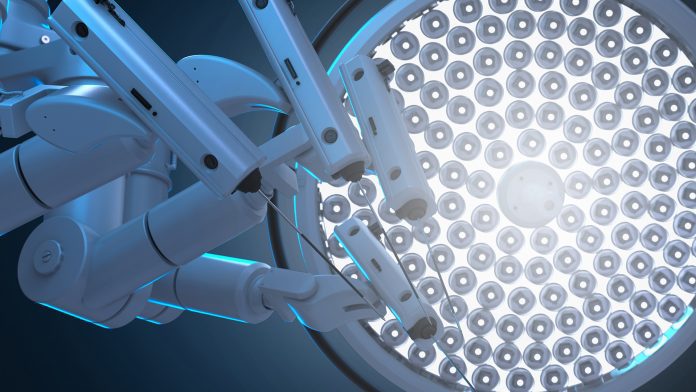
Dr Yuhang Chen, Associate Professor of Biomedical Engineering at the world-leading National Robotarium, explains how a new project that brings together experts from hospitals, universities, and industry aims to improve robotic cancer surgery.
Cancer surgery is complex. When a surgeon begins a procedure, they need to use all their years of knowledge and experience to decide how big to make the “surgical margin” around a tumour, the safety zone of healthy tissue they remove along with the growth. Make it too small and there’s a risk they won’t catch all the tumour, which could lead to more surgery; make it too large and it will take the patient longer to heal, increase their pain and could lead to more functional tissue loss than required.
Surgeons rely on a wide range of information to decide on the size of their surgical margin. As well as their experience, they draw on computerised tomography (CT) scans and other pre-operation images – occasionally even rushing samples of the surrounding tissue along to a pathology laboratory – so they can be analysed during the surgery and details fed back to the surgeon. During open operations, surgeons can also physically feel the characteristics of the surrounding tissue to help work out the extent to which cancer has spread.
Keyhole cancer surgery presents an obstacle. While less-invasive techniques provide much better outcomes for patients – reducing the risk of infection, speeding up recovery times, and leaving smaller scars – they remove the ability of the surgeon to feel around the tumour with their fingers. Now, a new tool being developed at the National Robotarium in Edinburgh by a team that brings together academics, clinicians, and industrialists aims to give surgeons the ability to “feel” even during keyhole operations.
Working in partnership
We’re building a probe that can take mechanical measurements of the tumour and the tissue surrounding it. This new tool draws on our team’s combined expertise in areas as diverse as fibre-optic sensors, micro-mechanical engineering, and laser manufacturing. It will work in the types of confined spaces that are found typically in keyhole surgery, especially when working with the pelvis or rectum, where there are risks to vital blood vessels and nerves, along with the bladder, bowel, sexual organs, and lower limbs.
The probe will also be linked to software that contains mechanical intelligence algorithms – these allow the program to compare the information from the probe with previous data about tumours, tissue, and surgical margins, allowing it to interpret what it is touching during cancer surgery. Together, our hardware and software provide a system that will further enhance the skills and experience of the surgeon, providing reliable quantitative data in real time.
These advances are only possible thanks to the talented team working on the project. Hugh Paterson, a consultant colorectal surgeon at the Western General Hospital in Edinburgh, and his colleagues bring years of experience to the table. Our industrial partners also contribute knowledge and expertise; IntelliPalp Dx was spun out from Heriot-Watt and Edinburgh universities and NHS Lothian in 2020 to help diagnose prostate cancer in primary-care settings, while Cambridge-based CMR Surgical is the brains behind the Versius robotic surgery system.
The next steps for cancer surgery
Our robot-assisted cancer surgery technique is one of many innovations taking place at the National Robotarium, a world-leading centre for robotics and artificial intelligence that brings together experts from Edinburgh and Heriot-Watt universities. Research being carried out at the National Robotarium stretches from devices to assist people who need care while living in their own homes to robots that can have conversations with residents in care homes. Away from healthcare, robots are being developed for a range of functions, from carrying out inspections of offshore wind turbines to search and rescue missions in areas hit by natural disasters.
The next step towards developing more tools for surgery and for health and social care is the opening of a dedicated National Robotarium building on 28 September 2022 at Heriot-Watt University’s Edinburgh campus. The purpose-built facility will help us to translate our cutting-edge research into new technology and techniques, giving us space to test our robots and our software in simulated environments, including a purpose-built flat for our assisted-living devices.
The National Robotarium is part of the Data-Driven Innovation initiative, supported by £21 million from the UK Government and £1.4 million from the Scottish Government. The initiative aims to turn Edinburgh into the data capital of Europe and is part of the wider £1.3 billion Edinburgh & South-East Scotland City Region Deal. Our own robot-assisted surgery technique was awarded £1.25 million by the Engineering & Physical Sciences Research Council, part of the UK Government’s UK Research & Innovation. Having such a broad range of support underpins our ability to take research and technology from the laboratory bench to the patient’s bedside, further enhancing the skills of surgeons to deliver safe and successful operations.

Dr Yuhang Chen, Associate Professor of Biomedical Engineering at Heriot Watt University
National Robotarium
https://www.hw.ac.uk/uk/research/the-national-robotarium.htm
https://www.linkedin.com/company/the-national-robotarium/
https://twitter.com/NRobotarium
https://www.youtube.com/channel/UCbAwGhzjQ_U_kyB4UDC5F5A/featured
























